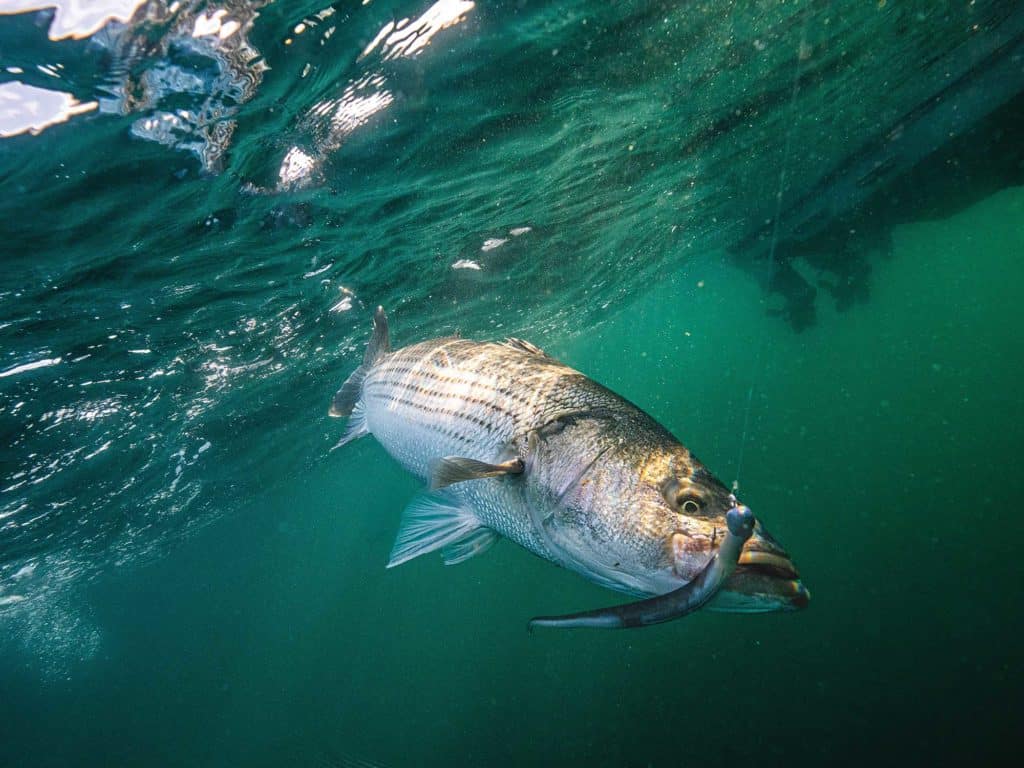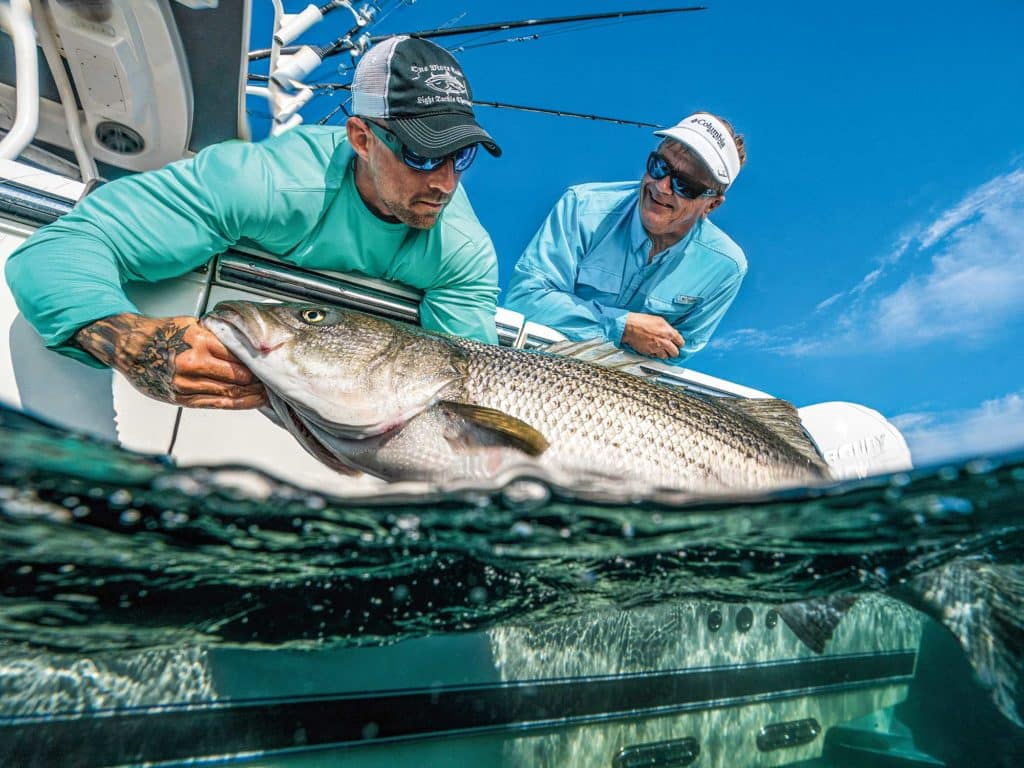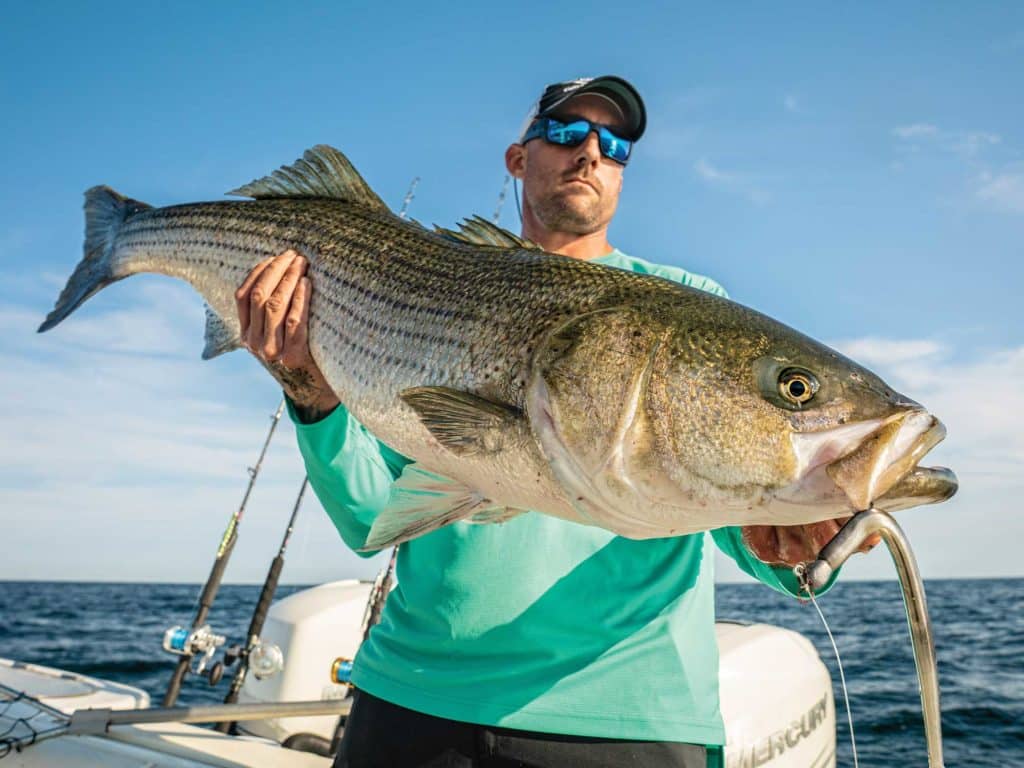
Some 20 feet separated Cory Crochetiere and me aboard MARC VI while jigging for striped bass off Rhode Island this past July. Using identical tackle—Penn rods and Battle III 5000 reels, 20-pound Sufix 832 braid, 40-pound fluoro leader, GT plastic eels and Atlas jig heads—Crochetiere was pitching a shutout.
After Cory released his sixth big striper, I studied what he was doing differently. This intel provided a boost toward getting strikes and finally into the groove. We went on to release a dozen bass upward of 40 pounds in four hours, and four more releases within a few hours during the following afternoon’s tide. Success came down to subtleties.
Drift and Drop
Artificial eels are especially cherished throughout the mid-Atlantic and Northeast for trophy striped bass. As basic as they appear pinned on a jig head, they demand a lot of attention to make them look alive. A master of manipulating the long plastic, Crochetiere practices this art nearly exclusively during New England’s trophy bass migration. Bassing out of Westerly, Rhode Island, we were jigging along the Southwest Ledge, concentrating on its 35- to 55-foot-deep crown. It was here where striped bass were marked blanketing the bottom. Each pass began a few hundred feet up-current of the fish and culminated a hundred or so feet down-current of the crown, usually with a single- or doubleheader score.
A Quick Study
My first lesson learned: Give these bass what they’re keyed into eating. Crochetiere fished Gravity Tackle’s 13.5-inch eel in Midnight Calamari. I began with flutter-style irons. When he pulled out to a five-fish lead, I had to switch over.
“One of their favorite natural forage is an eel, and it’s hard for them to pass up, regardless of the current forage species and size,” Crochetiere says. “These eels are large, and it’s imperative to match their size as well as their color. Midnight Calamari, Shimmering Eel and Au Naturale produce best for me. Early in the season, there is sometimes an abundance of squid on our inshore reefs. Then the Barbie Pink and Pearly Gold get the nod if the bass are keyed on squid. Definitely match the hatch.”
With just a couple of sea bass for my efforts, I couldn’t argue.

Holding in the Zone
Pair the eel with the lightest lead that will reach the fish. With a couple of knots of current, we accomplished this with 1.25-ounce jig heads. Heavier leads hang bottom frequently, feel unnatural to a fish, and are easier for a hooked bass to shake free. They also reduce an angler’s ability to maintain the feel of the plastic, its bumping bottom and the slightest hit.
Dialing in the Drift
Tides dictate feeding activity. However, a strong tide or wind and tide in unison makes it difficult to keep an eel within an active zone. Faced with light winds and a 1- to 2-knot current, our jigs reached bottom easily. However, keeping them there, where bass were holding, required constant free-spooling. If one drifted higher in the water column, it was ignored—save for two bass that drilled the baits halfway up during a fast retrieve.
“Nine times out of 10, these fish are stuck to bottom, avoiding current so as not to waste energy,” Crochetiere says. “Sometimes when the tide slows, these fish come off the bottom and chase baits in the midcolumn. I then switch to the Gravity Tackle Titan SwimHook so I can keep the bait higher and still work it slowly.
“I also like to fish the eels around the boulder fields on the east and south sides of Fishers Island. I’ll use the 1-ounce Atlas or Titan SwimHook, cast into the shoreline, and work the bait back out, just like a bucktail. Try slight pops of the rod tip and a brief fall of the eel, then reel in the slack and repeat.”
When the tide is ripping and the boat drifts quickly, Crochetiere suggests working the baits a little faster so as not to snag bottom. Extreme conditions also require using a lighter braid for less resistance in the water, upgrading jig size, and stemming the current with the boat. A drift anchor helps slow the pace of your boat and hold over prime bottom for much longer.
Gentle on the Action
As mentioned, nuance made all the difference in hooking up. We fished both eels along the bottom, but Crochetiere was gently lifting his rod straight up and lowering it, pacing the eel a foot or so off bottom. His technique was a slow, relaxed action, followed by free-spooling to reacquire bottom. Many times, a bass struck during the drop-back.
Conversely, I started with a more aggressive jigging motion, which proved as cold as a block of ice. I slowed my actions and began to score. I’d detect the eel creeping across bottom for a second or so, gently raising it a foot or two, then returning it to bottom.

A Faster Way to Set the Hook
The strikes initially threw me off, feeling more like a sea bass than a 30-plus-pound striper. Plenty of hits were also occurring while reacquiring bottom. However, I finally mastered this timing.
During free-spool, I’d feel a slight tap and brief pull of line. Prior to quickly engaging the drag and striking, the fish dropped the eel. My adjustment: While reacquiring bottom and feeling that light tap, I instantly cupped the spool and reared back. With a fish now hooked, I swiftly flipped the bail closed and enjoyed the fight.
Dead-Sticking Works
When fish are up in the water column and you have the space, fishing an extra outfit from a rod holder is a good way to catch bass. Depending on jig size, line paid out and drift, the eel will pulsate enticingly, especially with any rocking of the boat. Simply leave the drag engaged and let the fish hook itself. Basically, it’s an additional angler you don’t have to entertain, feed or split the catch with. However, what fun is it returning to the dock knowing you played second fiddle to a rod holder?
These Companies Make Great Eels
- Gravity Tackle: gravitytackle.com; Instagram: @gravitytackle
- Hogy Lures: hogylures.com; Instagram: @hogyfishing
- Berkley: berkley-fishing.com; Instagram: @berkleyfishing
- Storm: rapala.com; Instagram: @storm.fishing
Circle-Hook Chaos
Before there were soft plastics, eel-skin plugs and rigged eels got the nod. Anglers skinned and brined eels, using their durable skin to cover metal-lipped swimming plugs. The result was a deadly lure that produced even when live bait wouldn’t. But they required maintenance in the form of resalting after each use.
Rigged eels were less complex, made with a pair of hooks attached to a dead eel and fitted with an egg sinker. They cast and trolled well. An easier option was to rig a jig head to a fresh-dead eel’s mouth and zip-tie it in place.
In January 2021, the Atlantic States Marine Fisheries Commission directed states to adopt rules requiring inline circle hooks when using bait for stripers.
The new regs were created to avoid gut-hooking fish when fishing static and live baits, but created a major gray area when dealing with traditional lure-and-bait combos. One thing is certain: When rigging dead eels with hooks, use inline circles.
Regulators didn’t account for other fishing methods that might utilize baits as a supplement to a lure. For example, is a full-size eel rigged to a jig head legal? The best option is to contact your local enforcement agency to see how it interprets the 2021 ruling.
Of course, the easiest way to avoid the ire of Mr. Green Jeans is to use artificial eels, like those in this article. –Joe Albanese









